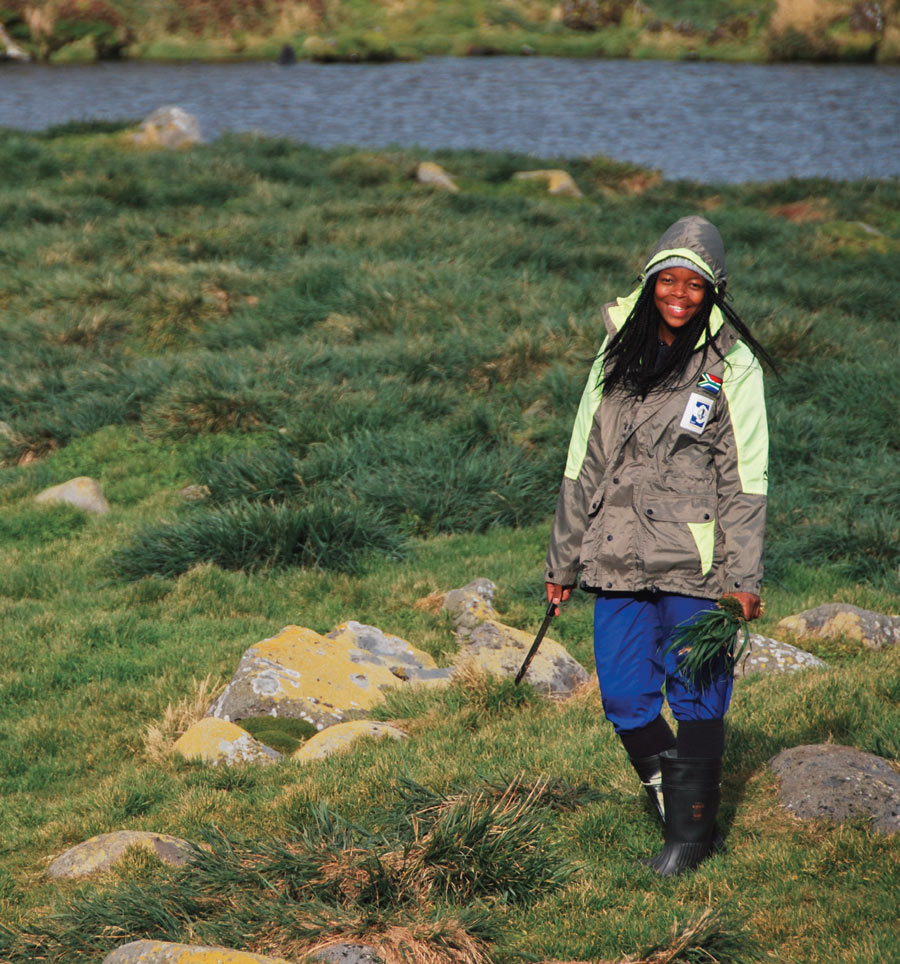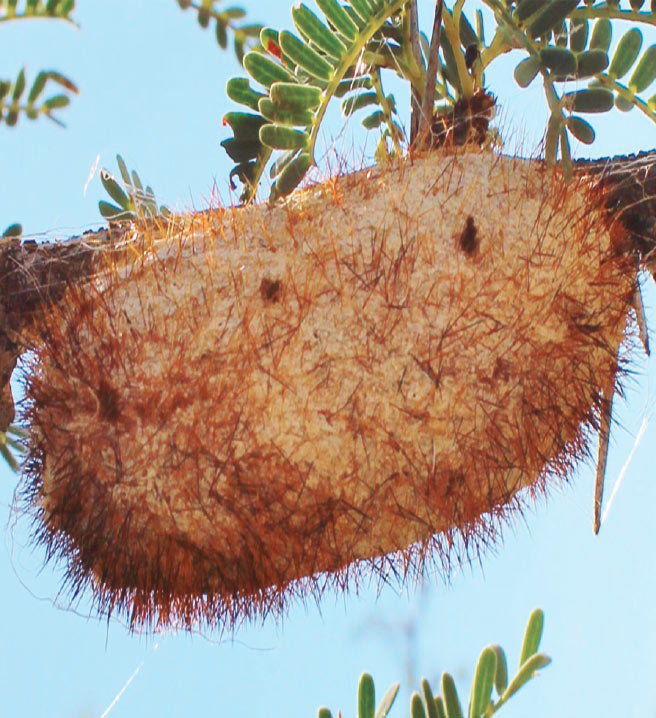 Rabia Mathakutha collects Poa cookii grass on Marion Island
Rabia Mathakutha collects Poa cookii grass on Marion Island
 A silk moth cocoon
A silk moth cocoon
 Mia Momberg surveys for Euphorbia clavarioides cushion plants in Echo Ravine at the Golden Gate Highlands National Park
Mia Momberg surveys for Euphorbia clavarioides cushion plants in Echo Ravine at the Golden Gate Highlands National Park
Dr Michelle Greve and Dr Peter le Roux in the Ecology Section of the Department of Plant and Soil Sciences are investigating how plants interact with their environment and with other organisms.
Traditionally, climate has been assumed to be the chief determinant of where species occur. However, recent research suggests that sometimes biotic interactions may be more important than abiotic environmental conditions for determining species occurrence patterns, particularly under stressful conditions. Dr Peter le Roux and his students are testing this idea using cushion plants (that is, species with a compact, hemispherical growth form) as model systems to examine if the outcome of interactions between plants changes with environmental conditions.
Dr le Roux’s team is focusing on plant interactions and cushion plants in two very different habitats: alpine grasslands in the Drakensberg, and tundra on sub-Antarctic Marion Island. Earlier results have shown that the widespread sub-Antarctic cushion plant Azorella selago strongly impacts on other plant species, with the cushion plant having a negative influence in milder environments but a positive effect on co-occurring plants under more stressful conditions. The team’s current research is building on this understanding and testing if this pattern holds across an entire ecological community, by examining vascular plants, mosses, lichens, invertebrates and microbial communities and exploring the mechanisms driving the environmental contingency in these interactions.
Preliminary results suggest that the positive impacts of A. selago allow some species to grow at higher altitudes than possible in the absence of the cushion plant, highlighting how even fine scale biotic interactions may affect broad scale biodiversity patterns.
In the Drakensberg the cushion plant Euphorbia clavarioides only grows in very rocky or eroding areas. In these stressful habitats the species provides a unique microhabitat, potentially allowing species to survive in areas that would otherwise be inhospitable. The research team is now testing whether, despite considerable differences in climatic and geological conditions and a 20-fold difference in plant species richness, the plant-plant interactions in the Drakensberg follow the same patterns as in the sub-Antarctic. Initial analyses suggest that in both study systems positive interactions are consistent under harsh environmental conditions.
Dr Michelle Greve and her students are also investigating how interactions between species affect their distribution, but over much larger areas. South Africa is home to two wild silk moth species that have high economic potential. These moths rely on a few species of host trees to complete their life cycle. In this study, the research team is investigating how best to incorporate knowledge of the distribution ranges of the host trees to predict where in Africa these moths will occur, and how climate change might affect them in the future. This knowledge can inform commercial harvesting under future climate change scenarios.
Alien species pose a serious threat to biodiversity. Globally, the increasing trend in international travel and trade has resulted in increased numbers of introductions of species into areas to which they are not indigenous. Ecologists in the Department of Plant and Soil Sciences are studying various aspects of plant invasions, including the risks and impact of non-indigenous plant species in South Africa and the sub-Antarctic, and how to prioritise their management. One focus is understanding the likelihood of new plant invasions, using the sub-Antarctic islands as a study system.
Despite their isolation, the islands of the sub-Antarctic seem to be prone to invasions by non-indigenous plant and insect species. To mitigate future invasions, Dr Greve and her team are using a range of tools to predict which alien species might be particularly likely to invade the sub-Antarctic islands by studying the climate requirements of potential invasives and understanding what traits allow existing invasives to become successful in the region. This approach has made it possible to identify a number of species with a high likelihood of establishing in the region and threatening the islands’ indigenous inhabitants. By examining alien plant species across the entire sub-Antarctic, their research will allow the governments managing individual islands to focus their efforts on reducing the likelihood of transporting such species to the islands, and to prioritise species on which to focus their eradication efforts.